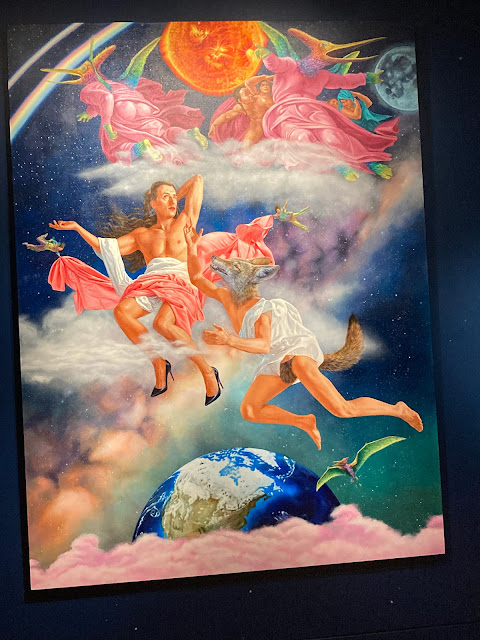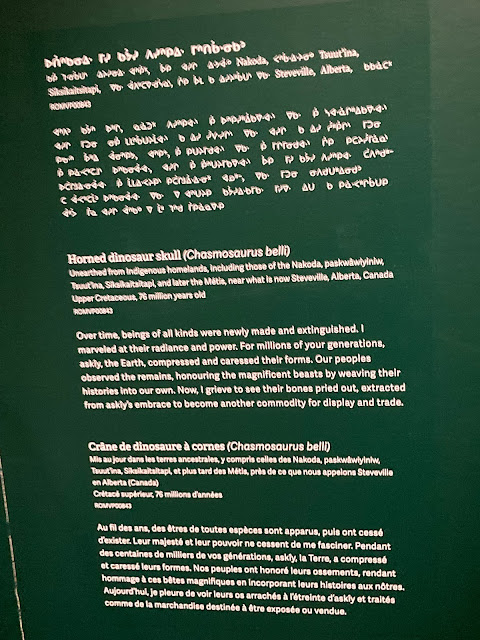Kent Monkman: Being Legendary at the Royal Ontario Museum - A Review
I acknowledge I live on the traditional territories of the Mississaugas of the Credit First Nation, The Haudenosaunee Confederacy, the Huron-Wendat and Wyandot Nations.
Since October last year there's been a unique little exhibit at the Royal Ontario Museum. Toronto-based Fisher Creek Cree artist Kent Monkman, who depicts through his two spirit alter ego Miss Chief Eagle Testickle the culture and history of Indigenous people, and the trouble and resilience against White colonialists, lampooning western art that glorified the white thieves (not settlers, they were thieves, plain and simple). I visited it two times so far: one in October when it debuted, and this month on the 8th. You can also view paintings on his website.
Now a warning to any Indigenous reader: I'm not one of you (I'm South Asian-Canadian), so I might and will get things very wrong. I apologise in advance.
While the primary focus is on Indigenous culture and history, there are a few fossil specimens at the start of the exhibit, as well as some art of prehistoric life that doesn’t quite qualify as palaeoart due to it's fantasy nature. The first is ... I Come From pâkwan kîsik, the Hole in the Sky, this art of the creation of Earth in the Mythology of certain tribes, that of a romans descending from the heavens to nascent earth. Observe Coyote and the... anthropomorphic pterosaurs around him, perhaps a blend of the old and new.
To my surprise there were both a Chasmosaurus skull and mammoth bones ftom the museum's collections on display too as I rounded the corners, with the indigenous homeland they were found on listed. I wasn't expecting them, but the rationale is that these are interpreted by Natives as giant ancestors of modern fauna. Sure enough, Kent makes art of the battle between the mythical Underwater Panthers and Thunderbirds (titled "Battle of the piyêsiwak and the misipisiwak"), represented by transitioning to multicoloured pterosaurs and Triceratops, as well as of mythical Little people interacting with their remains. I enjoyed it: I'm a sucker for mixing natural history and culture, as they have not always been separate.
The rest is on Native history and the very fraught relations between Indigenous people and White invaders, including the horrific humans right abuse that were residential schools, with Kent going for a more serious tone (as represented by discarded shoes). I didn't take any photos since a) I wasn't interested in them B) I was very uncomfortable and horrified by what I saw C) I don't want to disturb Indigenous readers. Fortunately, it ends with portraits of noted Indigenous people who have reclaimed their culture and work to help others.
I'm no art critic, but all of the paintings are very good. That is all I will say on it, as I can't think of anything else to say about them, besides scientific accuracy is not their focus at all, but metaphor, art, and whatnot.
In addition to requisite english and french, the exhibit's signage is in the indigenous language of Cree. It's an inclusive and respectful choice given the subject matter and potential visitors, and while it maybe rather sacrilegious to say, looks cool and interesting.
The use of colour on the walls to simulate mood for each section is also nice: purple for cosmic as seen around "I Come From pâkwan kîsik, the Hole in the Sky", and earthen green for what comes afterward as monsters are depicted roaming the earth.
My only issue with the exhibit? Many of the creatures in the art early on are copied from… somewhere else. Can you guess where? Lemme show you them again for a hint:
I'm glad the ROM is taking steps for more inclusivity and addressing it and other museums' crimes and role in colonialism. And honestly, I'm not sure I even need to improve the exhibit in any way.
- Exhibit Design - 9/10
- Species Variety - 6/10
- Interpretives - 8/10
- Information - 8/10
- Aging - 6/10
Overall, Being Legendary is a great exhibit. It makes you think, and the art can be both rich and playful and hauntingly sad, and its inclusion of fossils in the context of Indigenous mythology is also a nice touch. While this is hardly going to repair centuries of cultural genocide, it will certainly open visitors' eyes.
Thank you for reading this review. I'd recommend you visit the exhibit if/whenever you can before it closes in March... just as a new one opens. What is it about you ask? Well, what is considered by most people to be THE most famous dinosaur?











Comments
Post a Comment